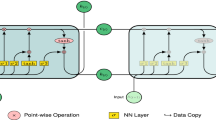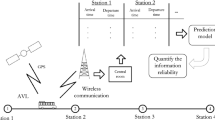Abstract
Intelligent transportation systems (ITS) play an important role in the quality of life of citizens in any metropolitan city. Despite various policies and strategies incorporated to increase the reliability and quality of service, public transportation authorities continue to face criticism from commuters largely due to irregularities in bus arrival times, most notably manifested in early or late arrivals. Due to these irregularities, commuters may miss important appointments, wait for too long at the bus stop, or arrive late for work. Therefore, accurate prediction models are needed to build better customer service solutions for transit systems, e.g. building accurate mobile apps for trip planning or sending bus delay/cancel notifications. Prediction models will also help in developing better appointment scheduling systems for doctors, dentists, and other businesses to take into account transit bus delays for their clients. In this paper, we seek to predict the occurrence of arrival time irregularities by mining GPS coordinates of transit buses provided by the Toronto Transit Commission (TTC) along with hourly weather data and using this data in machine learning models that we have developed. In our study, we compared the performance of a Long Short Term Memory Recurrent Neural Network (LSTM) model against four baseline models, an Artificial Neural Network (ANN), Support Vector Regression (SVR), Autoregressive Integrated Moving Average (ARIMA) and historical averages. We found that our LSTM model demonstrates the best prediction accuracy. The improved accuracy achieved by the LSTM model may lend itself to its ability to adjust and update the weights of neurons while accounting for long-term dependencies. In addition, we found that weather conditions play a significant role in improving the accuracy of our models. Therefore, we built a prediction model that combines an LSTM model with a Recurrent Neural Network Model (RNN) that focuses on the weather condition. Our findings also reveal that in nearly 37% of scheduled arrival times, buses either arrive early or late by a margin of more than 5 min, suggesting room for improvement in the current strategies employed by transit authorities.










Similar content being viewed by others
References
Balasubramanian P, Rao KR (2015) An adaptive long-term bus arrival time prediction model with cyclic variations. J Public Transport 18:1–18. https://doi.org/10.5038/2375-0901.18.1.6
Basyir M, Nasir M, Suryati S, Mellyssa W (2017) Determination of nearest emergency service office using haversine formula based on android platform. EMITTER Int J Eng Technol 5(2):270–278
Boser BE, Guyon IM, Vapnik VN (1992) A training algorithm for optimal margin classifiers. In: Proceedings of the fifth annual workshop on computational learning theory, ACM, New York, NY, USA, COLT ’92, pp 144–152. https://doi.org/10.1145/130385.130401
Chai T, Draxler RR (2014) Root mean square error (rmse) or mean absolute error (mae)? arguments against avoiding rmse in the literature. Geosci Model Dev 7(3):1247–1250. https://doi.org/10.5194/gmd-7-1247-2014
Chang H, Park D, Lee S, Lee H, Baek S (2010) Dynamic multi-interval bus travel time prediction using bus transit data. Transportmetrica 6(1):19–38
Che Z, Purushotham S, Cho K, Sontag D, Liu Y (2016) Recurrent neural networks for multivariate time series with missing values. Sci Rep. https://doi.org/10.1038/s41598-018-24271-9
Chen M, Liu X, Xia J, Chien SIJ (2004) A dynamic bus-arrival time prediction model based on apc data. Comput Aided Civ Infrastruct Eng 19:364–376. https://doi.org/10.1111/j.1467-8667.2004.00363.x
Chien SIJ, Ding Y, Wei C (2002) Dynamic bus arrival time prediction with artificial neural networks. J Transport Eng 128(5):429–438. https://doi.org/10.1061/(ASCE)0733-947X(2002)128:5(429)
Cho K, van Merriënboer B, Gülçehre Ç, Bahdanau D, Bougares F, Schwenk H, Bengio Y (2014) Learning phrase representations using rnn encoder–decoder for statistical machine translation. In: Proceedings of the 2014 Conference on Empirical Methods in Natural Language Processing (EMNLP), Association for Computational Linguistics, Doha, Qatar, pp 1724–1734. http://www.aclweb.org/anthology/D14-1179
Chopde NR, Nichat MK (2013) Landmark based shortest path detection by using a* and haversine formula. Int J Innov Res Comput Commun Eng 1(2):298–302
Drucker H, Burges CJC, Kaufman L, Smola AJ, Vapnik V (1997) Support vector regression machines. In: Mozer MC, Jordan MI, Petsche T (eds) Advances in neural information processing systems 9, MIT Press, Cambridge, pp 155–161, http://papers.nips.cc/paper/1238-support-vector-regression-machines.pdf
Duan Y, Lv Y, Wang FY (2016) Travel time prediction with lstm neural network. In: 2016 IEEE 19th international conference on intelligent transportation systems (ITSC), pp 1053–1058
Fu L, Yang X (2002) Design and implementation of bus–holding control strategies with real-time information. Transp Res Rec 1791(1):6–12
Fu R, Zhang Z, Li L (2016) Using lstm and gru neural network methods for traffic flow prediction. pp 324–328. https://doi.org/10.1109/YAC.2016.7804912
Goodfellow I, Bengio Y, Courville A (2016) Deep learning. The MIT Press, Cambridge
Hua X, Wang W, Wang Y, Ren M (2018) Bus arrival time prediction using mixed multi-route arrival time data at previous stop. Transport 33(2):543–554
Ingole P, Nichat MMK (2013) Landmark based shortest path detection by using dijkestra algorithm and haversine formula. Int J Eng Res Appl (IJERA) 3(3):162–165
Jeong R, Rilett R (2004) Bus arrival time prediction using artificial neural network model. In: Proceedings. The 7th international IEEE conference on intelligent transportation systems (IEEE Cat. No.04TH8749), pp 988–993. https://doi.org/10.1109/ITSC.2004.1399041
Kalman RE (1960) A new approach to linear filtering and prediction problems. Trans ASME J Basic Eng 82(Series D):35–45
Ke J, Zheng H, Yang HXC (2017) Short-term forecasting of passenger demand under on-demand ride services: a spatio-temporal deep learning approach. Transport Res Part C Emerg Technol. https://doi.org/10.1016/j.trc.2017.10.016
Kormáksson M, Barbosa L, Vieira MR, Zadrozny B (2014) Bus travel time predictions using additive models. In: 2014 IEEE international conference on data mining, pp 875–880. https://doi.org/10.1109/ICDM.2014.107
Kumar V, Kumar BA, Vanajakshi L, Subramanian SC (2014) Comparison of model based and machine learning approaches for 1 bus arrival time prediction. Transportation Research Board 93rd Annual Meeting. http://docs.trb.org/prp/14-2518.pdf
Liu L, Chen RC, Zhao Q, Zhu S (2019) Applying a multistage of input feature combination to random forest for improving mrt passenger flow prediction. J Ambient Intell Hum Comput 10(11):4515–4532
Liu Z, Yan Y, Qu X, Zhang Y (2013) Bus stop-skipping scheme with random travel time. Transport Res Part C Emerg Technol 35:46–56. https://doi.org/10.1016/j.trc.2013.06.004
Nextbus Nexbus public feed. https://www.nextbus.com/xmlFeedDocs/NextBusXMLFeed.pdf. Accessed 2020
Patnaik J, Chien S, Bladikas A (2004) Estimation of bus arrival times using APC data. J Public Transp 7(1):1
Shalaby A, Farhan A (2004) Prediction model of bus arrival and departure times using avl and apc data. J Public Transport 7(1):41–61. https://doi.org/10.5038/2375-0901.7.1.3
Srivastava N, Hinton G, Krizhevsky A, Sutskever I, Salakhutdinov R (2014) Dropout: a simple way to prevent neural networks from overfitting. J Mach Learn Res 15(1):1929–1958. http://dl.acm.org/citation.cfm?id=2627435.2670313
Star TT (2020) Ttc gives notes for affected customers arriving late for work. https://www.thestar.com/news/gta/2017/12/01/late-for-work-the-ttc-can-give-you-a-note-for-that.html. Accessed 2020
Sutskever I, Vinyals O, Le QV (2014) Sequence to sequence learning with neural networks. In: Ghahramani Z, Welling M, Cortes C, Lawrence ND, Weinberger KQ (eds) Advances in neural information processing systems 27, Curran Associates, Inc., pp 3104–3112. http://papers.nips.cc/paper/5346-sequence-to-sequence-learning-with-neural-networks.pdf
Tan PN, Steinbach M, Kumar V (2005) Introduction to data mining, 1st edn. Addison-Wesley Longman Publishing Co., Inc., Boston
Veness C (2018) Movable type scripts: calculate distance, bearing and more between latitude/longitude points. URL:https://www.movable-type.co.uk/scripts/latlong.html
Wang B, Huang J, Xu J (2019) Capacity optimization and allocation of an urban rail transit network based on multi-source data. J Ambient Intell Hum Comput 10(1):373–383
Wang J, Chen X, Guo S (2009) Bus travel time prediction model with v-support vector regression. In: 2009 12th International IEEE conference on intelligent transportation systems, pp 1–6
Xu J, Wu Y, Jia L, Qin Y (2020) A reckoning algorithm for the prediction of arriving passengers for subway station networks. J Ambient Intell Hum Comput 11(2):845–864
Yang M, Chen C, Wang L, Yan X, Zhou L (2016) Bus arrival time prediction using support vector machine with genetic algorithm. Neural Netw World 26:205–217. https://doi.org/10.14311/NNW.2016.26.011
Zhang P, Qi M (2005) Neural network forecasting for seasonal and trend time series. Eur J Oper Res 160:501–514. https://doi.org/10.1016/j.ejor.2003.08.037
Author information
Authors and Affiliations
Corresponding author
Additional information
Publisher's Note
Springer Nature remains neutral with regard to jurisdictional claims in published maps and institutional affiliations.
Rights and permissions
About this article
Cite this article
Alam, O., Kush, A., Emami, A. et al. Predicting irregularities in arrival times for transit buses with recurrent neural networks using GPS coordinates and weather data. J Ambient Intell Human Comput 12, 7813–7826 (2021). https://doi.org/10.1007/s12652-020-02507-9
Received:
Accepted:
Published:
Issue Date:
DOI: https://doi.org/10.1007/s12652-020-02507-9




